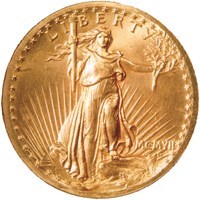Last updated: October 19, 2021
Article
Augustus Saint-Gaudens, Theodore Roosevelt, and the Coin

A Living Thing and Typical of Progress: Augustus Saint-Gaudens, Theodore Roosevelt, and the Coins
Augustus Saint-Gaudens and Theodore Roosevelt’s relationship was not only a working one, but also a friendly one. Their most famous project together was the beautifully designed ten- and twenty-dollar gold coins. Along with the coins, Saint-Gaudens also designed Roosevelt’s 1905 Inaugural Medal.In the years following the Civil War, the United States was going through a cultural shift. Large influxes of immigrants arrived as new manufacturing technology drove the economy. With these social and economic changes, Theodore Roosevelt found it more important than ever to create a distinct American culture.
During his presidency from 1901 to 1909, Roosevelt helped to create and promote American culture in the country and the world. One way did this was by commissioning an American artist, Augustus Saint-Gaudens, to design currency that represented American progress and ideals. Roosevelt chose Saint-Gaudens because he ushered in the nascent American art scene and because he often used American symbols and allegorical figures in his art such as angels, bald eagles, and stars and stripes.
Roosevelt had been impressed by many of Saint-Gaudens’ monuments, especially his 1902 monument of General William Tecumseh Sherman. In a letter to Saint-Gaudens, Roosevelt wrote,“But I can say with all sincerity that I know of no man, of no one living, who could have done it. To take grim, homely, old Sherman, the type and ideal of a democratic general, and put with him an allegorical figure, such as you did, could result in one of two ways -- a ludicrous failure, or striking the very highest note of the sculptor's art. Thrice over to the good fortune of our countrymen, it was given to you to strike this highest note.”[i]
Saint-Gaudens appreciated Roosevelt’s confidence but held some apprehensions when designing the coins. In 1906, he wrote to Roosevelt saying,“The making of these designs is a great pleasure, but the job is even more serious than I anticipated. You may not recall that I told you I was “scared blue” at the thought of doing that; now that I have the opportunity, the responsibility looms up like a spectre.”[ii]
Ultimately, Saint-Gaudens enjoyed designing the coins and discussing it with Roosevelt. Both men agreed that Greek coins should serve as initial inspiration but that the coins should have figures and symbols that represent American icons and values. Saint-Gaudens wrote to Roosevelt as he sketched his ideas for the $20 coin,“I have about determined on the composition of one side, which would contain an eagle very much like the one I placed on your medal with a modification that would be advantageous; on the other side some kind of, possibly winged, figure of liberty striding energetically forward as if on a mountaintop, holding aloft on one arm a shield bearing the stars and stripes with the word liberty marked across the fields; In the other hand perhaps a flaming torch, the drapery would be flowing in the breeze. My idea is to make it a living thing and typical of progress.”[iii]
Roosevelt especially liked Saint-Gaudens’ sketch of Lady Liberty on the $10 coin, which he suggested to Saint-Gaudens wear a Native American headdress. Roosevelt wrote to Saint-Gaudens,“I am so glad you liked the head of Liberty with the feather head-dress. Really, the feather head-dress could be treated as being the conventional cap of Liberty quite as much as if it was a Phrygian cap; and, after all, it is our Liberty - not what the ancient Greeks and Romans miscalled by that title - and we are entitled to a typically American head-dress for the lady.”[iv]
The obverse (front) side of the $10 coin features Lady Liberty wearing a Native American head-dress while the reverse (back) side features a standing eagle similar to the eagle on the 1905 Inaugural Medal. The completed $20 gold piece has Lady Liberty featured on the obverse side of this coin holding a torch and an olive branch, while the reverse side featured an eagle in flight.
Saint-Gaudens continued to write Roosevelt and work on the coins until his death in 1907. The coins were cast later that year and produced until 1933.[v]
After his death, Roosevelt honored Saint-Gaudens as an artist and friend by saying in a 1908 speech given at the Corcoran Gallery,“more beautiful than any coins since the days of the Greeks, and they achieve their striking beauty because Saint-Gaudens not only possessed a perfect mastery in the physical address of his craft, but also a daring and original imagination.”[vi]
In a thank you letter to Roosevelt, Saint-Gaudens’ widow, Augusta, wrote,“Such a tribute from you would, I know, have meant much to him especially the recognition of his labor on the coins into which he put his whole heart. Your presence with Mrs. Roosevelt gave to the memorial a character and meaning which without you it could not have happened and I hardly know how to thank you both for this expression of your friendliness now that he is gone.”[vii]
_______________________________________
[i] Theodore Roosevelt to Augustus Saint-Gaudens, 3 August 1903, https://www.theodorerooseveltcenter.org/Research/Digital-Library/Record?libID=o185569
[ii] Augustus Saint-Gaudens to Theodore Roosevelt, 28 June 1906, https://www.theodorerooseveltcenter.org/Research/Digital-Library/Record?libID=o53344
[iii] Augustus Saint-Gaudens to Theodore Roosevelt, 11 November 1905, https://www.theodorerooseveltcenter.org/Research/Digital-Library/Record?libID=o51780
[iv] Theodore Roosevelt to Augustus Saint-Gaudens, 14 March 1907, https://www.theodorerooseveltcenter.org/Research/Digital-Library/Record?libID=o198874
[v] Saint-Gaudens National Historical Park. “Design History of the 1907 Gold Coinage.” National Park Service. March 16, 2021.
[vi] Augustus Saint-Gaudens. Theodore Roosevelt Center. https://www.theodorerooseveltcenter.org/Learn-About-TR/TR-Encyclopedia/Culture-and-Society/Augustus%20Saint%20Gaudens
[vii] Augusta Saint-Gaudens to Theodore Roosevelt, 18 December 1908, TR Center - Letter from Augusta Saint-Gaudens to Theodore Roosevelt (theodorerooseveltcenter.org)
